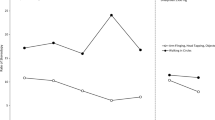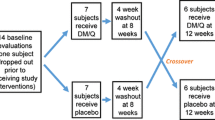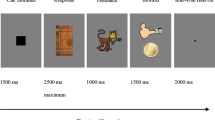Abstract
This double-blind and placebo-controlled clinical trial in autistic children had three objectives: (a) to replicate earlier findings that haloperidol administration is associated with a significant reduction of behavioral symptoms; (b) to further assess its safety when given on a short-term basis: and (c) to assess whether it has an effect on discrimination learning. Forty-five children, 2.02 to 7.58 years old (M=4.49), completed this crossover design, with random assignment to treatment sequences. Haloperidol was shown to be a powerful therapeutic agent when administered for 4 weeks and free of side effects; at doses ranging from 0.25 to 4.0 mg/day (M=0.844), there was a clinically and statistically significant reduction of a variety of symptoms. Under the given conditions, the children failed to learn on either haloperidol or placebo.
Similar content being viewed by others
References
American Psychiatric Association. (1980).Diagnostic and statistical manual of mental disorders (3rd ed.). Washington, DC: Author.
Anderson, L. T., Campbell, M., Grega, D. M., Perry, R., Small, A. M., & Green, W. H. (1984). Haloperidol in infantile autism: Effects on learning and behavioral symptoms.American Journal of Psychiatry, 141, 1195–1202.
Anderson, G. M., & Hoshino, Y. (1987). Neurochemical studies of autism. In D. J. Cohen & A. M. Donnellan (Eds.),Handbook of autism and pervasive developmental disorders (pp. 166–191). New York: Wiley.
Campbell, M. (1987). Drug treatment of infantile autism: The past decade. In H. Y. Meltzer (Ed.),Psychopharmacology: The third generation of progress (pp. 1225–1231). New York: Raven Press.
Campbell, M., & Palij, M (1985). Behavioral and cognitive measures used in psychopharmacological studies of infantile autism.Psychopharmacology Bulletin, 21(4), 1047–1053.
Campbell, M., Anderson, L. T., Green, W. H., & Deutsch, S. I. (1987). Psychopharmacology. In D. J. Cohen & A. M. Donnellan (Eds.) (R. Paul, Assoc. Ed.),Handbook of autism and pervasive developmental disorders (pp. 545–565). New York: Wiley.
Campbell, M., Anderson, L. T., Meier, M., Cohen, I. L., Small, A. M., Samit, C., & Sachar, E. J. (1978). A comparison of haloperidol, behavior therapy and their interaction in autistic children.Journal of the American Academy of Child Psychiatry, 17, 640–655.
Campbell, M., Perry, R., Small, A. M., & Green, W. H. (1987). Overview of drug treatment in autism. In E. Schopler & G. B. Mesibov (Eds.),Neurobiological issues in autism (pp. 341–356). New York: Plenum Press.
Cohen, D. J., Caparulo, B. K., Shaywitz, B. A., & Bowers, M. B. (1977). Dopamine and serotonin metabolism in neuropsychiatrically disturbed children.Archives of General Psychiatry, 34, 545–550.
Fish, B., Shapiro, T., & Campbell, M. (1966). Long-term prognosis and the response of schizophrenic children to drug therapy: A controlled study of trifluoperazine.American Journal of Psychiatry, 123, 32–39.
Muller, P. G., Crow, R. E., & Cheney, C. D. (1979). Schedule-induced locomotor activity in humans.Journal of the Experimental Analysis of Behavior, 31, 83–90.
Overall, J. E., & Campbell, M. (1988). Behavioral assessment of psychopathology in children: Infantile autism.Journal of Clinical Psychology, 44, 708–716.
Psychopharmacology Bulletin. (1985). Rating scales and assessment instruments for use in pediatric psychopharmacology research [Special feature].31(4), 765–770.
Spencer, E. K., & Campbell, M. (in press). Infantile autism. In T. Dinan (Ed.),Principles and practices of biological psychiatry. London: Clinical Neuroscience Publishers.
Young, J. G., Kavanagh, M. E., Anderson, G. M., Shaywitz, B. A., & Cohen, D. J. (1982). Clinical neurochemistry of autism and associated disorders.Journal of Autism and Developmental Disorders, 12, 147–165.
Author information
Authors and Affiliations
Additional information
This work was supported in part by National Institute of Mental Health grant MH 32212 and was aided by Social and Behavioral Sciences Research grant 12-108 from March of Dimes Birth Defects Foundation (Dr. Campbell). The authors thank Dr. Dennis Grega and Mr. Charles W. Hamilton for participating in this research; Dr. Michael Palij for analyzing the discrimination learning data; Dr. John E. Overall for statistical consultation; and McNeil Pharmaceutical for Haldol and matching placebo tablets.
Rights and permissions
About this article
Cite this article
Anderson, L.T., Campbell, M., Adams, P. et al. The effects of haloperidol on discrimination learning and behavioral symptoms in autistic children. J Autism Dev Disord 19, 227–239 (1989). https://doi.org/10.1007/BF02211843
Issue Date:
DOI: https://doi.org/10.1007/BF02211843




